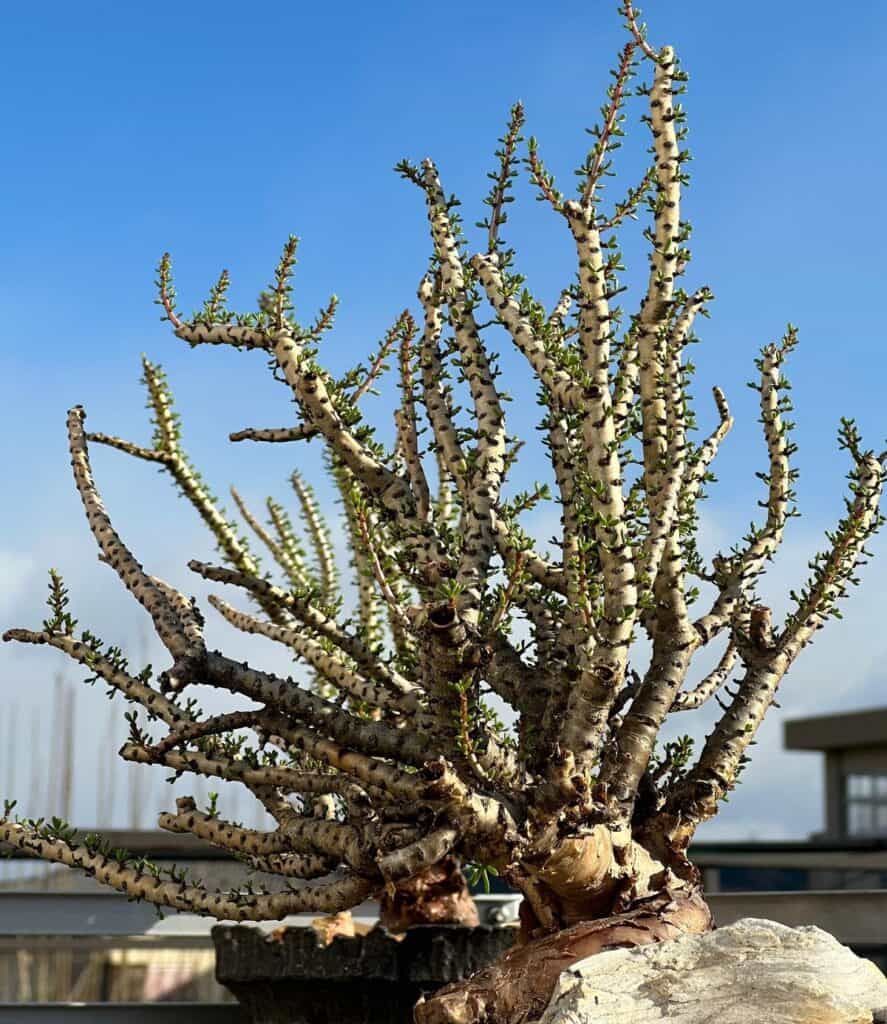Ceraria namaquensis: A Forked, Woody Stemmed Botanical Spectacle
Buckle up, plant lovers! We’re about to dive into the weird and wonderful world of Ceraria namaquensis – a spiky succulent that looks like it came straight out of a Dr. Seuss book. With its forked, waxy stems and fleshy leaves, this desert dweller is guaranteed to turn heads and have your friends asking, “What in the world is that?!”

Contents
About Ceraria namaquensis
This slow-growing shrub or small tree, native to the Namib desert region of Namibia, can reach heights of 4-6 feet tall. Its thick, upward-growing stems fork out in an almost horn-like fashion, creating an otherworldly silhouette. The semi-deciduous leaves are short, succulent, and covered in spines – perfect for fending off hungry desert critters.
But the real showstopper? The profusion of dainty pink flowers that blanket the plant in spring when male and female blooms appear. Talk about stopping traffic! No wonder this quirky species gets its name from the Greek word “cera” meaning “little horn.”
Related Post:
1,000 Types of Succulents With Pictures and Names
How To Care For Ceraria namaquensis
Light
These badlands beauties need plenty of bright, indirect light to truly thrive. Direct sun can scorch their fleshy leaves. If growing indoors, position near a sunny window or use a grow light to mimic its native intense yet filtered rays.
Water
Like a true desert native, Ceraria handles drought like a champ but relishes a good soak every now and then. During the hotter months, give it a nice deep watering every 2-3 weeks, allowing the soil to fully dry between drinks. Come winter, ease up to once a month.
Soil
This picky plant wants a well-draining, slightly acidic soil mix. A cactus and succulent blend with some extra perlite or coarse sand works wonders for replicating its gravelly Namibian home. Having the right breathable soil helps prevent rot.

Fertilizer
As heavy feeders, Cerarias need a nutrient boost during the growing season. An balanced liquid fertilizer diluted to half strength every 4-6 weeks does the trick.
Temperature and Humidity
Temperatures between 60-80°F are ideal, but these tough cookies can handle short cold snaps down to about 40°F. As for humidity, they like it on the drier side – high moisture levels leave them vulnerable to pests and diseases.
Pests and Problems
Speaking of pests, mealybugs, spider mites and aphids find Ceraria irresistible. Check leaves regularly and treat with an insecticidal soap or neem oil at the first sign of trouble. Root rot from overwatering is also an issue to watch for.
Pruning
Since it grows at a glacial pace, Ceraria only needs a light pruning once a year to remove any dead or damaged growth and shape it up a bit. Prune in early spring before new growth emerges.

Potting and Repotting
These top-heavy plants need a sturdy, well-draining pot to accommodate their fleshy frame. Repot every 2-3 years in spring, going just one pot size up and using a cactus/succulent soil mix.
Propagating Ceraria namaquensis
While propagating Ceraria from seeds or cuttings is possible, grafting onto a hardy rootstock like Portulacaria afra (Elephant’s Food) is the most common and reliable method:
- Take a cutting with a wedge-shaped base from a healthy Ceraria plant
- Make a matching wedge cut in the rootstock stem
- Carefully insert the scion cutting, lining up the cambium layers
- Bind firmly together and seal the union with grafting wax
- Leave a few shoots on the rootstock to support the scion
- Place in bright, indirect light and keep soil barely moist
- In a few months, new growth signals successful grafting!
With a little TLC, this zany succulent will reward you with years of otherworldly appeal. Who knows, it may even inspire the next great Dr. Seuss character!
